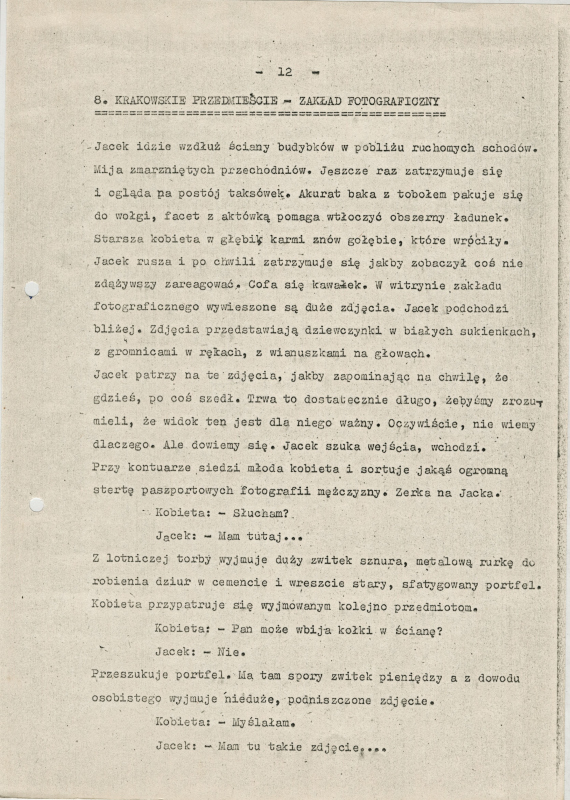Krakowskie Przedmieście
One of the most recognizable and impressive boulevards in Warsaw’s historical center, Krakowskie Przedmieście stretches approximately 1.1 kilometers from the Castle Square to the statue of Nicolaus Copernicus, forming the northern part of the Royal Route. Its current name is a reference to Krakow, Poland’s former capital, to which the boulevard once led.
Decalogue Five
Jacek Łazar wanders around Krakowskie Przedmieście as he prepares to commit his heinous crime. He passes a group of soccer hooligans and witnesses a brutal beating, and himself wreaks havoc by shoving a young man in a public restroom and chasing away a flock of pigeons being fed by an elderly lady. He behaves more civilly only for a moment, when he visits a photo studio, where he has an enlargement made of his sister Marysia’s first communion portrait. The loving emotions he projects in this scene contrast starkly with the crime he is about to commit. The dark profile of Jacek’s face in the car of his victim, the taxi driver (Jan Tesarz), is forebodingly similar to that of the devil ornament dangling from the windshield of the vehicle. Exhausted by the murder, Jacek switches on the radio and rests for a moment in the Polonez. A children’s song about a lion plays over the speakers. The girl’s voice contrasts painfully with the forever-stifled groans of the murdered taxi driver. It is like a call to conscience that cannot be silenced. The murderer tears the radio out of the dashboard and throws it into the river on whose banks he bludgeoned the driver to death just moments before. Only a single fatal blow to the head is shown in Decalogue Five, but in the film version of the episode, A Short Film About Killing, Jacek is shown repeatedly striking his victim with a rock. Audiences at a 1988 screening in Cannes shouted: “Enough!”, and some viewers left the cinema, unable to bear the sight of a murder committed in this manner.
Mikołaj Jazdon
“Signs of Cain, Abraham, Lazarus…”
Michał Klinger The novice lawyer poses the following unsolved problem to the legal authorities: “Since Cain, no person has ever been deterred by punishment.” While we know the motive of Cain’s crime (jealousy), we don’t know why God gave Cain reason for jealousy by rejecting his sincere sacrifice. Because of God’s disturbing role in the tragedy of Cain and Abel, tradition has ascribed a more human motive to the crime: Cain and his brother had an argument “in the field” over their sister (who is assumed to have existed, if the only human family was to bear offspring, though the Bible makes no mention of her). The motive behind Jacek Łazar’s crime is never revealed, but various signs shown in the moments before the murder suggest that the only bright spot in his life was his beloved sister. Just before his execution, Jacek is tortured by the question: if “it weren’t for the death of little Marysia, maybe it wouldn’t have come to this.” Though it wasn’t the motive of the crime in question, the guilt he feels over his reckless drinking with a friend who later climbed onto a tractor and ran over the girl “in the field” is likely the unspoken motive of Jacek’s actions, and certainly the reason for the remorse he feels as he goes to his death. Łazar was not as fortunate as Cain, who received a “sign” of salvation from God. In the final scene we see the “field” belonging to Cain and his sisters, with a “Star” shining above it.
There’s also “Abraham’s sign” (to recall: the Biblical patriarch came close to murdering his own son). Abraham purchased a family grave in which generations of fathers and sons could enjoy “eternal rest.” To be laid to rest next to his father is the convict’s modest but meaningful final request, one that Kieślowski highlights using a surprising detail: Jacek bears the surname Łazar and, like Lazarus, he awaits the Gospel.
